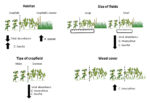Factors driving rodent abundance in agricultural landscapes of Central Argentina
Luciana B. Adduci, María Busch, Vanina León, Jimena FraschinaChanges in land use in the Pampean region have led to an increase in pastures and cultivated fields and a decrease in native grasslands, which mainly remain at the borders of cultivated fields. In the province of Buenos Aires, there is a trend to increase the size of fields, eliminate the edges between them, and increase the proportion of the area cultivated with soybeans. Borders function as corridors and refuges for native fauna, so this reduction may affect rodent abundance, although this effect may vary according to the habitat affinities of the species. Our goal was to evaluate the effect of the size of fields and the decrease in the proportion of border habitats on the rodent community. The study was conducted in the province of Buenos Aires, in Central Argentina. Rodents were surveyed in 12 fields and their borders. Overall rodent density and both species of Calomys showed negative effects of field size on their abundance, while for A. azarae there were no significant effects. Calomys laucha was more abundant in maize crop fields, and Calomys musculinus did not show an effect on habitat, but its abundance in crop fields increased with weed cover. Akodon azarae showed strong habitat selection for borders. In summary, changes in the agricultural landscape with an increase in cropland at the expense of natural and semi-natural habitats affect rodent communities, and this effect would have consequences through their trophic interactions, both as consumers of plant and insect species as well as food sources for mammalian and avian predators.
Determinantes de la abundancia de roedores en paisajes agrícolas de Argentina central. Los cambios en el uso de la tierra en la región Pampeana han conducido a un aumento de pasturas y campos cultivados y a una disminución de pastizales nativos, los cuales permanecen principalmente en los bordes de campos. En esta región existe una tendencia al aumento en el tamaño de los campos, a la eliminación de los bordes entre ellos y a un aumento en la proporción del área cultivada con soja. Los bordes funcionan como corredores y refugio para la fauna nativa, por tanto, su reducción puede afectar a la abundancia de roedores, dependiendo de las afinidades de hábitat de cada especie. Nuestro objetivo fue evaluar el efecto del tamaño de los campos y de la disminución en el área relativa de los bordes. El estudio se realizó en la provincia de Buenos Aires, Argentina central. Se muestrearon 12 campos y sus bordes. La abundancia total de roedores y las de ambas especies de Calomys mostraron efectos negativos del tamaño de los campos. Calomys laucha fue más abundante en los campos de cultivo de maíz, mientras que la abundancia de Calomys musculinus en campos aumentó con la cobertura de malezas. A. azarae mostró fuerte selección por los bordes. En resumen, los cambios en el paisaje agrícola, con un aumento de las áreas cultivadas a expensas de ambientes naturales y seminaturales, afecta a las comunidades de roedores y este efecto puede trasladarse a otros niveles tróficos, debido a su papel como consumidores de plantas e insectos y como fuente de alimento para aves y mamíferos predadores.
